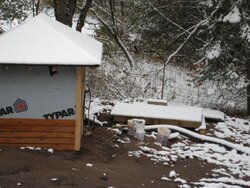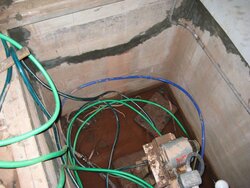Hi - This is a bit of a story so please bare with me. I have a house in the Catskills Mountain's , NY. The house gets its water from a well which is housed in an "pump" house. This pump house is a wooden structure (no heating) on a 10x10 ft concrete slab, with a 5x5 hole on it that is concrete lined. this hole is about 6' deep. The well pump is situated at the bottom of the hole, on a 1/2 foot pedestal. The well line comes out of the floor (of this 6'foot hole) for about a foot, and then goes horizontally through the concrete walls and then underground to the house.
My family has owned this property for a 45 years and we have always closed up the house for the winter. That included draining the water from all the water lines, including the line from the main house to the pump house. I have rebuilt the house for use in the winter and want to know what to do about this pump house.
I am concerned that the water will freeze in either the pump or the line to the main house. The frost line is probably about 4 feet in this area. And even though the pipes are below that line, they are exposed to air in this hole/cavity. The cavity is covered with a large wooden trap door and the entire thing is enclosed a wooden shed, but we have prolonged cold during the winter, sometimes weeks where the temperature does not go above freezing, and i think that the pipes would freeze there. The water would not be running for weeks at a time since i would only use the house on weekends at most 2x per month. I believe that the previous owners of the house (built in 1880) did spend the winters in the house so the water lines in the pump house could not have frozen, but they probably used the water daily.
So what do people with a similar situation do in this situation? I could wrap "heat-tape" around the pipes/pump, and i could insulate the cavity and put a heater in there, or is any of this really needed? help!
Of course there is a twist, and its really a separate issue. I recently noticed a large crack in the wall of the cavity, about 2 feet down from ground level. The crack is not serious enough for a structural issue, but when it rains, plenty of water accumulates at the bottom of the cavity, 5" last i looked. That water eventually drains through the a drain in the bottom of the cavity, but I am pretty sure that I need to seal up this crack. I don't want to dig up the outside wall of the cavity since near this wall runs a drainage ditch which has running water when it rains. I fear that if I disturb the natural course of that water, then the drainage ditch will drain toward the wall with the "repaired" crack. And since its unlikely the repair will be 100% this might make matters worse. I should seal it from within. What should I use? Hydraulic cement? Roofing cement? I should probably chip away at the crack to get a clean edge. However, as long as the water drains away, do i even need to do anything here?
Thanks for reading and looking forward to suggestions. -yurij
My family has owned this property for a 45 years and we have always closed up the house for the winter. That included draining the water from all the water lines, including the line from the main house to the pump house. I have rebuilt the house for use in the winter and want to know what to do about this pump house.
I am concerned that the water will freeze in either the pump or the line to the main house. The frost line is probably about 4 feet in this area. And even though the pipes are below that line, they are exposed to air in this hole/cavity. The cavity is covered with a large wooden trap door and the entire thing is enclosed a wooden shed, but we have prolonged cold during the winter, sometimes weeks where the temperature does not go above freezing, and i think that the pipes would freeze there. The water would not be running for weeks at a time since i would only use the house on weekends at most 2x per month. I believe that the previous owners of the house (built in 1880) did spend the winters in the house so the water lines in the pump house could not have frozen, but they probably used the water daily.
So what do people with a similar situation do in this situation? I could wrap "heat-tape" around the pipes/pump, and i could insulate the cavity and put a heater in there, or is any of this really needed? help!
Of course there is a twist, and its really a separate issue. I recently noticed a large crack in the wall of the cavity, about 2 feet down from ground level. The crack is not serious enough for a structural issue, but when it rains, plenty of water accumulates at the bottom of the cavity, 5" last i looked. That water eventually drains through the a drain in the bottom of the cavity, but I am pretty sure that I need to seal up this crack. I don't want to dig up the outside wall of the cavity since near this wall runs a drainage ditch which has running water when it rains. I fear that if I disturb the natural course of that water, then the drainage ditch will drain toward the wall with the "repaired" crack. And since its unlikely the repair will be 100% this might make matters worse. I should seal it from within. What should I use? Hydraulic cement? Roofing cement? I should probably chip away at the crack to get a clean edge. However, as long as the water drains away, do i even need to do anything here?
Thanks for reading and looking forward to suggestions. -yurij



